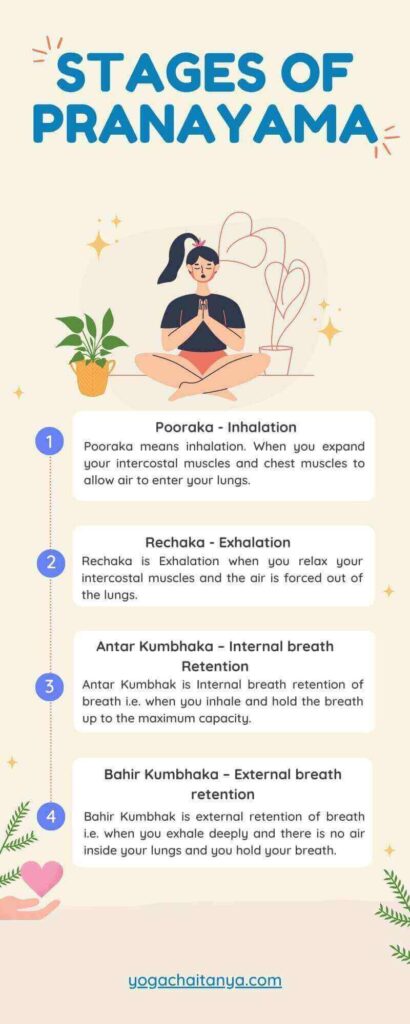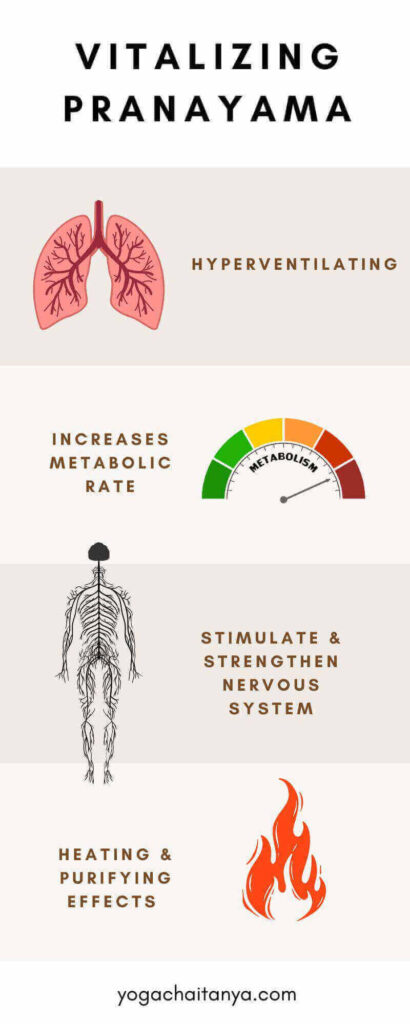Pranayama Secrets the Ultimate Health Guide
-
Written By: Sukhvinder-chaitanya
- Published On:
- Last Updated: December 5, 2024
Whenever you hear the word Pranayam or Pranayama, the first thing that comes into mind is breathing, then another thing is “it is boring”
The majority of people practicing yoga are mainly interested in asanas. That is physical posture & they simply ignore the Pranayama. But pranayamas are one of the most important aspects of yoga practice, and one should never skip the pranayama practice.
This is the most comprehensive guide to Pranayama, its types, its stages, classification, its benefits, and scientific research ever. In this guide, you will learn everything you need to know about the Pranayama and its details.
With proper knowledge and practice of Pranayama, many people can heal their physical, mental, and emotional problems.
As a beginner or an advanced yoga practitioner, you may have questions related to Pranayamas.
This Ultimate Guide to Pranayama: Science Meets Spirituality will provide you with in-depth knowledge of the topic. Here you will learn:
- What is Pranayama?
- The subtle aspect of Pranayama
- How it can affect your physical & energetic body
- What are the stages of Pranayama?
- Classification of pranayama i.e. Types of Pranayama
- Benefits of Pranayama
- Scientific Reserch on diffrent types of Pranayama
This is the most complete guide available on the internet. Let’s dive right in…
Table of Contents
What is Pranayama?
The Sanskrit word Pranayama is the combination of two words “Prana” & “Yama” or you can say “Pran” & “ayama.” Both derivations will explain the essence of pranayama.
The word “Pran” or “Prana” means means ‘vital energy’ or ‘life force’ or cosmic prana which is invisible. It is the force that exists in all things.
Modern science and medicine cannot prove the existence of prana. Because there is no such equipment or instrument available to measure subtle life energy.
The air we breathe in not only contains nitrogen, oxygen, argon, carbon dioxide, neon, helium, and hydrogen but prana also. The subtle life energy.
The word Yama means restraint or control. So you can say that pranayama i.e. (prana + Yama), is the practice of the control or restraint of prana. The practice to control a moving life force, by stopping it to the extent of complete cessation, to harness its power.
The word Ayama means extension or expansion. Therefore pranayama means “Extension or Expansion” of the dimension of prana.
Pranayama is a precise science that provides methods to understand the essence of prana. The practices involve guiding the respiration beyond its normal limit, stretching it, speeding it up, and slowing it down. This helps to experience a wide range of respiration on both the gross and subtle levels.
What are the different stages of pranayama?
Most of the people think that Pranayama or breathing exercises have only two aspects. That is Inhalation and Exhalation but that’s not the complete picture. So let’s decode it.
Pranayama has four stages i.e.
- Pooraka – Inhalation
- Rechaka – Exhalation
- Antar Kumbhaka – Internal breath retention
- Bahir Kumbhaka – External breath retention
Pooraka: Pooraka means inhalation. When you expand your intercostal muscles and chest muscles to allow air to enter your lungs.
Rechaka: Rechaka is Exhalation when you relax your intercostal muscles and the air is forced out of the lungs.
Antar Kumbhak: Antar Kumbhak is Internal breath retention of breath i.e. when you inhale and hold the breath up to the maximum capacity.
Bahir Kumbhak: Bahir Kumbhak is external retention of breath i.e. when you exhale deeply and there is no air inside your lungs and you hold your breath.
Inhalation is described as the active or positive breath, exhalation as the passive or negative breath, and kumbhaka represents the transcendence of duality.

Classification of pranayama
What are the different types of pranayama?
By types I do not mean Anulom Vilom Pranayama, Kapalbhati Pranayama, or Bhastrika Pranayama. These are the names of particular Pranayama.
By Classification, I mean what effect is seen on your body & mind when you practice a particular category of Pranayama.
Different pranayamas are done by modulating the stages of pranayama ( i.e. pooraka, rechaka, and kumbhaka) in certain way. Some of these pranayamas will increase the heat in your body whereas some will cool your body. Some pranayamas stimulate, while others harmonize and relax the nervous system.
Different types of Pranayama
Pranayamas are classified under two categories: Vitalizing Pranayamas and Tranquilizing Pranayamas.
Vitalizing Pranayama
Vitalizing pranayamas consists of hyperventilating techniques. Rapid and deep breathing increases alveolar ventilation and stimulates the blood flow in the lungs. Further, in those areas where blood circulation is sluggish and even dormant.
They have a stimulating effect on the whole body due to the rapid muscular movement and increased metabolic rate induced in all parts of the body.
These hyperventilating techniques exercise the lungs and abdomen. Further, they stimulate, balance, and strengthen the nervous system. Vitalizing pranayamas have heating and purifying effects on the body and mind.

Tranquilizing Pranayama
Tranquilizing pranayamas consist of hypoventilating techniques. Hypoventilating techniques are slow and subtle. Further, they stretch the capacity of respiration up to the end of the spectrum.
The practice of these breathing techniques reduces the metabolic rate. Further, reducing the brain wave frequencies, leads to relaxation and a meditative state.
Practioner experiences a greater sense of control over the nervous system. During the practice of Hypoventilating techniques, carbon dioxide levels may be slightly increased, but the oxygen levels remain normal.

Yoga Chaitanya invites you for 200 hour yoga teacher training in India at affordable prices. Yoga Chaitanya is a traditional yoga and meditation teacher training school with a scientific outlook. We follow the spiritual teachings of Maharishi Patanjali, Bhagwat Gita, Buddhism, Sikhism, Sufism, and Tantra. Learn to design and teach Yoga Postures, meditation techniques, and mudras with confidence. Book Now!
Start your Yoga Journey to Transform your Life !
What are the Benefits of Pranayama?
Benefits of Pranayama
Pranayam or Pranayama, the breathing exercises are the key aspect of yogic science. Although many people ignore Pranayama or find it boring. People who are practicing Pranayama regularly are getting incredible benefits at physical, mental & energetic levels.
A lot of scientific research is done to study the benefit of pranayamas.
Each type of pranayama has particular benefits associated with it. That details we will cover in the respective blog of that pranayama.
Here are some general benefits of all the pranayamas:
- Pranayamas are an excellent way to achieve good physical and mental health, neuro-muscular coordination, and a radiant body.
- By Regular practice of pranayamas lungs and muscles involved in the breathing process become healthy, strong, and efficient. It strengthens the respiratory system.
- Regular practice of pranayamas improves Lung capacity. Improved Lung capacity means more stamina & more energy for physical & mental activities.
- Practice of pranayamas engages the movement of the diaphragm. Due to the movement of the diaphragm, the abdominal organs get massaged. This increases the blood flow in the abdominal organs. Further, increasing their efficiency & improving digestion.
- Practice of pranayamas increases the supply of oxygen & prana to vital organs like the brain and the heart. This improves their efficiency & protects the brain and the heart from severe diseases.
- The practice of Pranayama balances the sympathetic and parasympathetic nervous systems. This improves the function of the nervous system. A balanced nervous system promotes better sleep and reduces the risk of stress-related disorders.
- Pranayama helps to strengthen the cardiovascular system of the body. Pranayama practice lowers blood pressure and improves heart health. Controlled breathing helps to maintain an optimal heart rate. This reduces the risk of cardiovascular diseases.
- Both vitalizing and tranquilizing pranayamas help to improve blood circulation. By practicing pranayama the prana and oxygen-rich blood reaches all parts of the body, promoting cellular health.
- People who are sensitive to seasonal allergies must practice pranayama.
- Pranayama helps to alleviate symptoms of allergies. It improves the immune system and reduces inflammation.
- The regular practice of pranayama techniques like Bhastika, Kapalbhati followed by Bharamari Pranayama or Ujjayi Pranayama, or Anulom Vilom Pranayama helps to relieve tension headaches and migraines.
- The vitalizing pranayamas like Bhastika and Kapalbhati have a detoxifying effect on the body. Further, they help to eliminate toxins from the body, cleansing the system and promoting overall health.
- Regular practice of vitalizing pranayamas like Bhastika and Kapalbhati improves the metabolic rate of the body leading to weight management.
- Tranquilizing pranayamas lead to better sleep quality, combating insomnia, and promoting restful sleep.
- The practice of Pranayama triggers the release of endorphins. These “feel-good” hormones, leads to a better mood state and a sense of happiness.
- Pranayama improves the efficiency of the brain by purifying the Nadis i.e. energy channels. The practice of pranayama purifies & activates Ida, Pingla & Sushumna Nadis. i.e. feminine, masculine & spiritual energy channels.
- Regular practice pranayamas helps to manage stress, anxiety & maintain emotional stability.
- As per the Yoga Sutras, Maharishi Patanjali says pranayama has 2 main objectives at the spiritual level i.e.
- Regular practice pranayamas remove the shadow or covering over Vivek Buddhi (i.e. Intellect)
- The practice of pranayamas trains the mind for Dharana i.e. concentration and Dhyana i.e. meditation.
Scientific Research on Pranayama
Now I will share the Scientific Research on 3 types of Pranayama with you. My aim in sharing these Scientific Research papers is to motivate you to practice the pranayamas.
Research on Nadi Shodhana Pranayama
Nadi shodhana pranayama is one of the most important yoga practices.
In 2007, Yoga Research Foundation (YRF), Munger, India, conducted a study in association with the national corporate organization Bharat Heavy Electricals Ltd. (BHEL)
This study was conducted to evaluate the benefits of Nadi shodhana pranayama on the cardiovascular system & nervous system.
30 adults suffering from hypertension participated in this research study.
It was found that the practice of Nadi shodhana pranayama for one month (in the ratio of 1:1 without kumbhaka, i.e. without breath retention) brought down both systolic and diastolic blood pressures.
After the research, it was found that systolic blood pressure was reduced by 10 mmHg on average. And by the end of two minutes, it continued to fall during and after the practice (total 14.5 mmHg). The diastolic blood pressure also showed parallel changes with a total fall of 4.2 mmHg.
This research study also indicated the practice of Nadi shodhana activates the parasympathetic nervous system.
Research on Ujjayi Pranayama
In 2006, Yoga Research Foundation (YRF), conducted a research study in Bhopal to study the effects of ujjayi pranayama.
- 22 asthma patients
- 11 Hypertension Patients
- 7 Healthy Adults
participated in this research study.
All these participants practiced ujjayi pranayama for five minutes every day, over one month.
The asthma patients gained the most from the practice. Oxygen saturation in the blood increased from 0.75 percent up to five percent (maximum).
During the practice of Ujjayi pranayama, the constant partial contraction of the epiglottis creates a positive airway pressure which prevents the closure of smaller bronchi towards the end of exhalation.
This is helpful for asthma patients to improve oxygenation and empty the lungs (minimizing air trapping), thus allowing the next inhalation to be more effective.
The slower rate of breathing encourages steady flow in contrast to the turbulent flow during bronchospasm, reducing airway resistance to the airflow so there is less work for the respiratory muscles. The asthmatic has to spend less energy for the act of breathing and the level of fatigue experienced during acute asthma is reduced.
This is why ujjayi pranayama is very useful during an asthma attack.
Hypertension patients, practicing ujjayi pranayama recorded a significant fall in systolic BP (by 20 mmHg) and diastolic BP (5 mmHg) which continued for two minutes after the end of practice.
Research on Bhramari Pranayama
Research 1
In 1993 Munger Hospital, India conducted a clinical research project in cooperation with the Bihar School of Yoga to study the effects of Bhramari Pranayama.
Dr. Vibha Singh examined 448 pregnant women over one year. All these females went through the same treatment i.e. (medical check-ups, dietary advice, pre-birth instruction, etc.)
Whereas 112 women, practiced Bhramari Pranayama for 5- 10 minutes daily (twice a day) during their entire pregnancy till the first phase of the actual birth.
It was observed that the group of 112 women practicing Bhramari pranayama experienced
- Normal blood pressure for all, compared to 25% in the control group with high blood pressure.
- Lower number of miscarriages (2% compared to 8% of the control group)
- Fewer premature births (2.6% compared to 5% of the control group)
- 25% shorter labor
- Generally little pain during labor
- Only one case (1%) of Caesarean section compared to 4% in the control group
- None of the newborns suffered from lack of oxygen (0% against 12%)
Greater average weight for newborns (3325 g compared to 2850 g).
The results indicated that the regular practice of Bhramari pranayama during pregnancy alleviates anxiety and stress. It regulates better hormone balance, which promotes the birth of healthy children.
In another study conducted by Dr. Singh, Bhramari pranayama provided multiple benefits in surgical patients, showing shorter healing time, less infection, reduced requirement of anesthetic, and fewer post-operative problems.
Research 2
Another study published by the National Center for Biotechnology Information (NCBI) explains the Immediate Effects of Bhramari Pranayama on Resting Cardiovascular Parameters in Healthy Adolescents.
In this study, sixty healthy adults of both sexes ( males and females) participated. This group of sixty healthy adults was randomly divided into two groups: the Bhramari Pranayama group (30 people) and the Control group (30 people).
The Bhramari Pranayama group practiced Bhramari pranayama for 45 min (5 cycles) and the control group practiced normal breathing (12-16 breaths/min).
After 45 minutes it was found that there was a significant reduction in Heart rate (HR) and Blood pressure (BP) Bhramari Pranayama group in comparison to the control group.
Heart rate (HR) was measured by radial artery palpation method and blood pressure was recorded in the supine position after 5 minutes of rest by sphygmomanometer.
Frequently Asked Questions about Pranayama
What is Pranayama?
Pranayama is a science of breath control. Pranayama is a yogic practice of the control or restraint of prana. Prana means life energy. The practice to control a moving life force, by stopping it to the extent of complete cessation, to harness its power. Pranayama also means “Extension or Expansion” of the dimension of prana.
How often should I practice Pranayama?
If you are a beginner, then you should practice pranayama for 10-15 minutes daily. Slowly you can increase the duration and frequency as per your comfort.
Can Pranayama help with anxiety?
Yes, regular practice of pranayama help to manage anxiety. Pranayama activates the parasympathetic nervous system leading to relaxation, reducing anxiety, and promoting a sense of calm.
Can anyone practice Pranayama?
Yes, Anyone can practice pranayamas. It does not matter what age group or fitness level you belong to. But make sure you cross-check the precaution and contradictions of the pranayama before doing it.
Are there any side effects of Pranayama?
The practice of Pranayama is safe if you follow the precaution and contradictions of a particular pranayama. However, in some cases, if you are overdoing breath retention, or practicing advanced Pranayama and hyperventilating techniques then it may lead to dizziness or discomfort.
Can Pranayama help with sleep problems?
Yes, tranquilizing pranayama techniques, like Sheetali Pranayama, Sheetkari Pranayama, Bharamari Pranayama, Ujjayi Pranayama, and Anulom Vilom Pranayama helps to calm the mind and promote better sleep.
Is Pranayama a spiritual practice?
Yes, Pranayama is considered a physical and spiritual practice in yoga. The practice of Pranayamas helps to harmonize the body and mind, increasing self-awareness and leading to spiritual development and growth.
Can Pranayama cure diseases?
Yes, regular practice of Pranayamas can help cure chronic diseases, some scientific research and data also prove this. But, please note pranayama are not a substitute for medical treatment. It can complement medical treatment, aid in overall well-being, and support the healing process.
Can Pranayama improve my meditation practice?
Yes, Pranayama prepares the body and mind for meditation by calming the thoughts and increasing focus. Patanjali sutras also say: one should practice asanas, then pranayama finally go into meditation.
Is Pranayama a religious practice?
No, pranayama is not associated with a particular religion, it is a pure science of breath awareness. Pranayama has roots in ancient yogic philosophy. But it is not limited to any specific religion, Anyone can practice pranayama.
Conclusion
So, try incorporating pranayama into your daily practice and see the results.
I hope you liked this post. Now I will like to hear from you. What did you think of today’s post?
Or maybe if you have a question about Ultimate Guide to Pranayama: Science Meets Spirituality. Let me know by leaving a comment below.
Yoga Chaitanya International Institute is one of the leading Yoga Teacher Training schools in India. Our unique courses and programs give a transformational life-changing experience.
Join our 200 Hour Yoga Therapy Teacher Training program. It is carefully designed using an integrated approach to yoga, meditation, Ayurveda, and other alternative healing practices.
Start your Yoga Journey to Transform your Life !

About the Author: Sukhvinder Singh Chaitanya
Sukhvinder Singh (Chaitanya) is an experienced yoga teacher. (ERYT-500 & YACEP with 20,000+ hours of teaching experience) He is a master yoga teacher in Ashtanga Vinyasa Yoga, Vinyasa Flow, Hatha Yoga, Yin Yoga, Iyengar Yoga, Ayurveda & Laughter Yoga. He has been teaching yoga, laughter yoga & meditation all across the globe in teacher training programs, workshops & corporate sector for almost 10 years. He's the founder and director of the Yoga Chaitanya International Institute, a leading Yoga Teacher Training school in the world. He shares his expertise in his blogs and his YouTube Channels.
